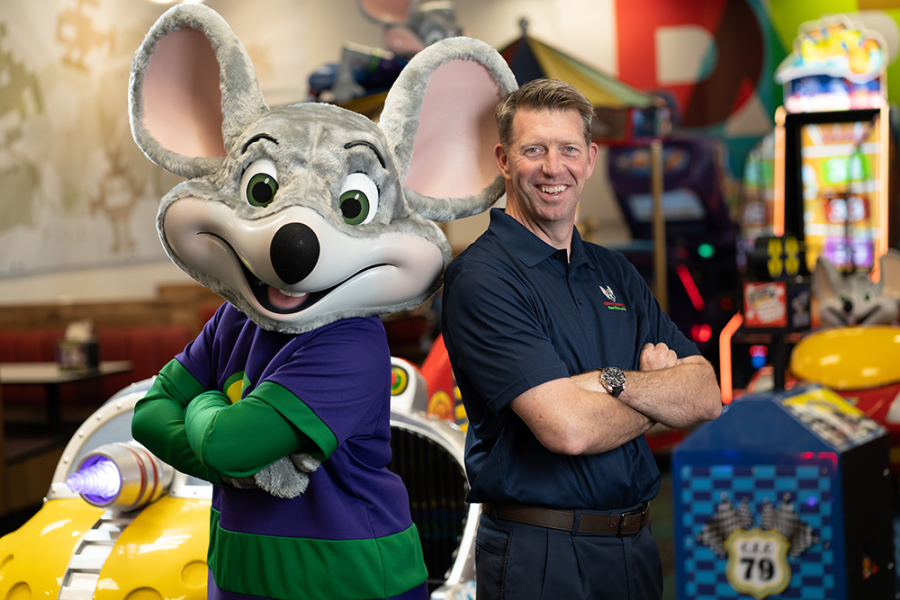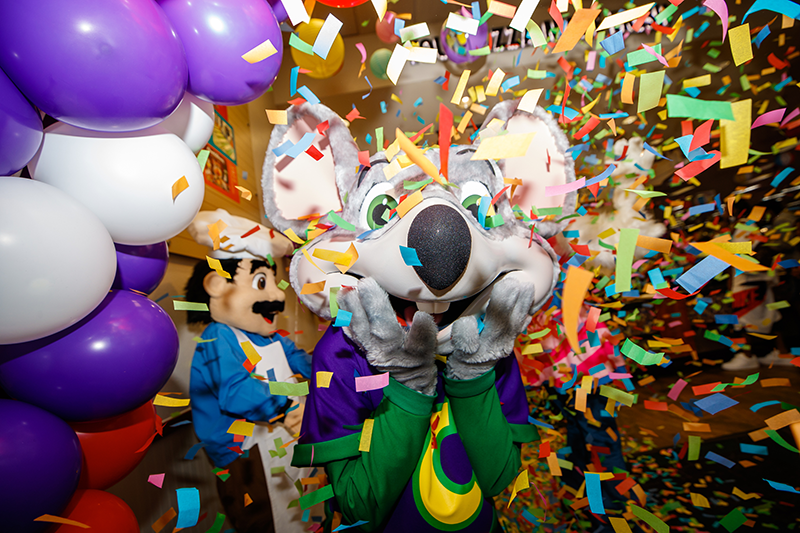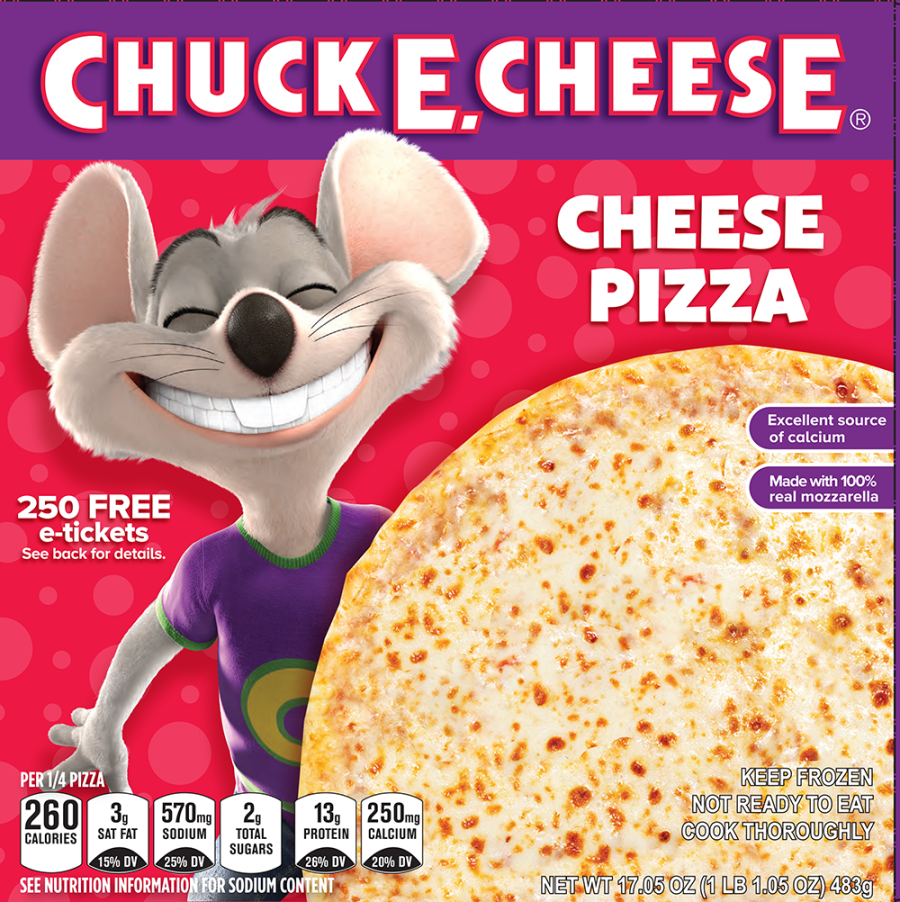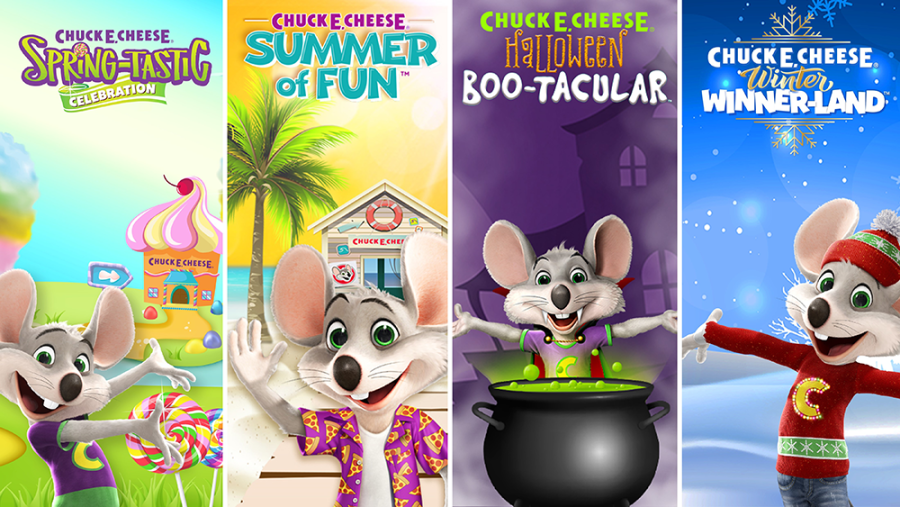A Whole New Game at Chuck E. Cheese

Some four-and-a-half decades after it began, it was nearly game over for the iconic Chuck E. Cheese family entertainment centers (FECs) and pizza restaurants when the COVID-19 pandemic brought parent company, CEC Entertainment, to its knees. But David McKillips, CEC’s charismatic CEO, helped it successfully emerge from bankruptcy. Now, he is guiding the company through the pandemic and reimagining the brand to position it for the next generation of fans.
Talk about timing. Coming on board in January 2020, McKillips had to make the difficult decision to temporarily shutter the company’s 775 locations in March due to the conditions imposed by the virus. CEC couldn’t withstand the impact of the closures.
“Unfortunately, we didn’t have the strength in our balance sheets to survive the pandemic,” he says. The company filed for Chapter 11 in June 2020.
It’s hard to keep a good mouse down, however. Recognizing the potency of the Chuck E. Cheese name and intellectual property, its overseers never considered abandoning the brand. Generating more than $900 million in sales in 2019, CEC’s fundamentals were sound.
“Quite frankly, the business was healthy,” says McKillips. “We really had a debt issue.”
Coming out of bankruptcy with a new line of credit in late December 2020, the CEO and his team developed strategies to operate during the pandemic. They had furloughed some folks in the corporate office and part-time employees in the field, but they decided to keep all of their full-time general managers at the stores on the payroll. The company knew as it came out of the pandemic that it would be important to maintain brand standards—the managers’ “muscle memory,” as McKillips puts it.

CEC Bakes Up a New Brand
With its dining rooms and arcades closed, the first order of business was pivoting to an off-premise food model. Chuck E. Cheese is among the largest pizza companies in the world. Unlike its competitors, however, it did not have much experience in promoting or selling its product for takeout or de-livery.
CEC signed deals with major third-party home delivery services such as Uber Eats but discovered less-than-enthusiastic demand for the chain’s existing menu items. By launching Pasqually’s Pizza & Wings, CEC was among the first national companies to pioneer the concept of a ghost kitchen. Although Pasqually’s is named after one of the Chuck E. Cheese characters, there are no other overt connections to the original brand. Sharing the same kitchen as its restaurants, it crafted a distinct pizza with more sauce, a different type of cheese, and more robust flavors. Dishes also include wings, meatball dunkers, and cheesy bread. The goal was to appeal to an older demographic than the families with young children that typically come to hang with Chuck E. Cheese and the gang.
McKillips says the company had plans to create a home delivery program, but the pandemic accelerated its rollout. The delivery-only Pasqually’s brand will continue after the threat of COVID-19 subsides. The virtual kitchen concept has been a hit, he adds, but not enough to keep the company growing.
To achieve sustainability, CEC had to figure out how to bring the Chuck E. Cheese experience back to guests amid the pandemic. What could it do to make its dining rooms and FECs safer and more appealing once they were able to reopen?

Technology is the Ticket to Success
Among the changes, the company moved to an e-ticket platform for its redemption games. CEC developed plastic, reusable cards on which customers can store their digital tickets. In addition to providing a touchless method to safely handle tickets, it is also an environmentally friendly alternative that saves the company a tremendous amount of money. Plus, it gives guests the ability to quickly redeem their earnings at the gift counter without having to deal with handfuls of paper tickets.
The sites also limited capacity, enacted social distancing measures, conducted temperature screenings, and introduced other COVID-19-era policies. The most significant initiative was a phone app that CEC was able to quickly roll out.
“We hunkered down and worked with our marketing, IT, and development teams to launch a Chuck E. Cheese loyalty and personalization program and mobile app in just three months,” McKillips says. “Now we have 650,000 users.”
The app provides a direct link to many of the brand’s most loyal end engaged customers. It also serves as a hub for a multitude of features. Users can place contactless orders at facilities (which have been enhanced with Wi-Fi, along with device charging ports and outlets at every table), schedule birthday parties, and learn about special offers. All the while, they can earn and redeem rewards points good for e-tickets, game play, and other incentives. Soon, the app will be able to track, store, and redeem e-tickets.
App users will also soon be able to access digital content, such as “Afternoon Fun Break,” a series of videos the company launched during the pandemic that features the Chuck E. Cheese characters. Also available on YouTube Kids, they include songs and other entertainment, as well as activities. The videos are part of a strategy to reach customers in the stores, at home, and online—wherever they may be.
There is plenty of pent-up demand driving customers back to Chuck E. Cheese locations, and McKillips says that sales are improving. But guests that still may not be comfortable coming in to eat pizza and play games can take Chuck E. Cheese with them. They can use the app or go online to order food—including family packs that bundle pizzas, desserts, goody bags, and activity sheets—pick it up at their nearest Chuck E. Cheese location, and enjoy it at home. The videos help round out the at-home experience.

McKillips Fell in Love with the Industry
The “Afternoon Fun Break” videos are an example of McKillips’ efforts to capitalize on the popularity of the Chuck E. Cheese character and extend the brand through original content, licensing, and entertainment. He knows a thing or two about popular costumed characters and the preschool market after a long career in parks and attractions.
McKillips says his first date was at Six Flags St. Louis. That wasn’t enough to drive him into the industry, but landing a chance job at SeaWorld Orlando during college did the trick. Despite his modest start at the park, which included cleaning up trash, McKillips fell in love with the business.
“I couldn’t believe you could work and get paid for making other people happy,” he says.
After college, he landed a full-time job at SeaWorld Parks and transferred to Pennsylvania to work at Sesame Place for several years. While there, McKillips saw the powerful draw of Elmo and Big Bird. He shifted to DC Comics and got to work with Six Flags, the theme park home of Superman, Batman, and the brand’s other superheroes. That led to a 13-year-long stint with the park chain where McKillips says he ran almost every department, including the international group and in-park revenue, overseeing food, games, and merchandise.
“I really got a 360-degree view of the themed entertainment world,” he explains.
His experience has informed his approach at CEC and the direction in which he wants to take the company.
“When I joined, we were operating as a restaurant first that served great food and offered entertainment,” McKillips says. “I came to Chuck E. Cheese knowing that we are family entertainment first. We’re changing the mentality of the company to really appreciate that entertainment drives our business.”
Even after permanently closing 54 locations in the bankruptcy’s fallout, the company still lays claim as the world’s largest FEC. It racks up 2 billion game plays every year, and gaming represents the largest percentage of its revenue.
Games and entertainment have been a core part of the company from the very beginning. Founded in 1977 by Nolan Bushnell, the video arcade pioneer who invented “Pong” and founded Atari, Chuck E. Cheese restaurants combined pizza with the nascent games. They also included an animatronic band fronted by the namesake character. The restaurants became the go-to place for children’s birthday parties.

Adding New Seasonings to the Recipe
Hosting over a half million parties every year, Chuck E. Cheese still counts these celebrations as a vital part of the business.
“We are the No. 1 birthday party destination in the country,” says McKillips. “It’s the DNA of the company.”
But the CEO wants to tinker with that DNA to increase attendance and revenue. This past May, the chain debuted “Summer of Fun,” a three-month event that included themed menu items, décor, and programming. Taking a cue from parks, it also featured a Summer Fun Pass that offered families weekly game play, e-tickets, food, and other perks throughout the season for a discounted fee. It generated about 100,000 members. Part of a new “4 Seasons of Fun” strategy, the event calendar also includes “Halloween Boo-tacular,” “Winter Winner-land,” and “Spring-tastic Celebration.”
McKillips is also tinkering with the stores themselves. As part of a brand reimagination, the company remodeled 30 locations in 2021 and plans to overhaul 350 more over the next three years. The refreshed stores emphasize interactivity. For example, instead of passively watching Chuck E. perform (the classic animatronics are being phased out), kids can dance with the big cheese when the walkaround character joins the fun every hour. They also include floor-to-ceiling video monitors, displaying content that is attuned to today’s tech-savvy tots.
“The newly remodeled locations scream entertainment,” says McKillips. The Halloween limited-time menu offered slime cupcakes with googly eyes and pizzas in the shape of pumpkins. “That’s putting entertainment in our food,” he notes.

In June, the company also opened its first signature store in Brandon, Florida. At 25,000 square feet, it is 78% bigger than existing locations and includes about 35 more games, 20% of which are small rides and interactive play experiences for young kids. There are multiple jumbo-sized video screens and an interactive dance floor to keep children active and engaged. A second signature location is set to open in Northern California in early 2022.
CEC owns a similar chain, Peter Piper Pizza, with more than 100 locations mostly in Arizona, Texas, and New Mexico. It appeals to an older demo-graphic of kids ages 8 to 14 and includes beer on its menu for parents. While it also offers games, McKillips says it is a food-first brand that has been doing well during the pandemic.
“I think Peter Piper is one of the secret weapons of this company,” he notes, adding that CEC recently purchased 10 locations from a large franchisee in the Tucson area and will open two more near San Antonio. “We think there’s opportunity to grow this brand.”

Becoming a Global Brand
There are several Peter Piper restaurants in Mexico, and Chuck E. Cheese has about 80 international locations, mostly in Latin America and the Middle East. It recently opened stores in El Salvador, Chile, and Peru and has plans to open locations in Bahrain and Romania, which will be its first entry into Europe. The company hopes to develop another 60 locations over the next five years with a focus on Southeast Asia, China, and Japan.
“Now we operate a domestic brand with an international division,” McKillips says. “My goal is that we become a global company.”
To that end, he wants to make Chuck E. Cheese a world-renowned character beyond the stores and is talking to toy companies, animation studios, apparel makers, and others. In July, the company signed a licensing partnership with the Kroger Company to bring Chuck E. Cheese-branded frozen pizza to its 2,000 grocery stores. The boxes include themed games and help drive traffic to the stores via an imprinted code that can be redeemed for e-tickets.
McKillips estimates that almost 1 billion people have enjoyed a slice with the famous mouse through the years.
“It’s a multigenerational property that has such affinity for kids, young parents, and now, their grandparents. The brand has been able to reinvent itself over the decades,” he says. “We’re ready for the next generation of Chuck E. Cheese—for today’s kids who want entertainment in a bit of a different way.”
